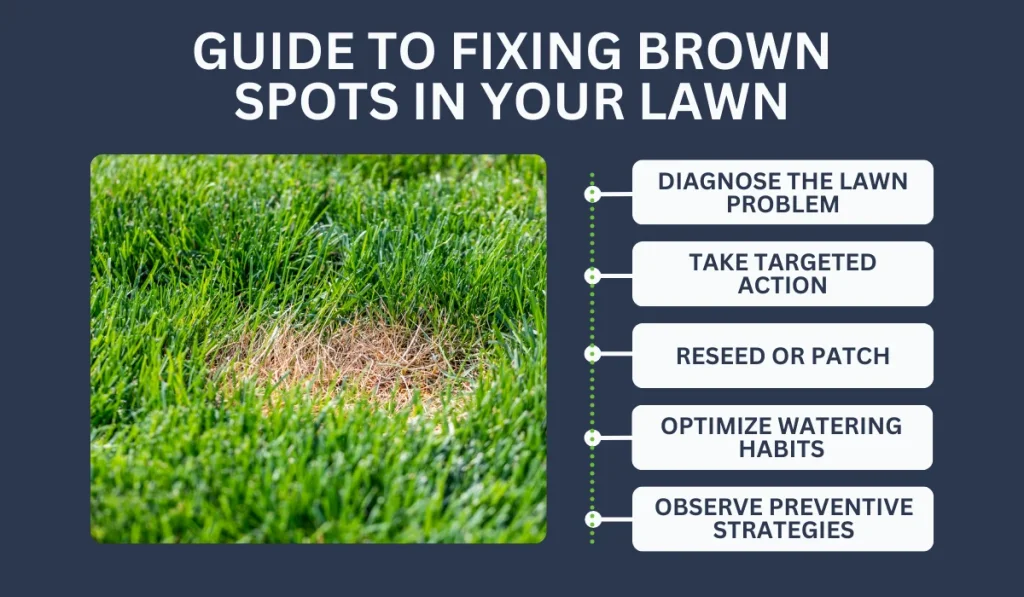Brown spots in your lawn can be a real eyesore, turning your vibrant green lawn into a patchy mess.
Identifying the cause of brown spots is the first step to fixing them. This could be anything from pests to fungal infections to insufficient watering techniques.
Stick around to learn effective strategies for getting your lawn back to its lush, green state.
Key Takeaways
- Identifying the root causes of brown spots, from fungal diseases to pet activity, is crucial for effective lawn care.
- Proper nutrition and using fertilizers based on soil tests are key to preventing and treating brown areas.
- Specific treatments like fungicides and beneficial nematodes are necessary to combat lawn pests and fungal diseases.
- Repair brown spots by regularly reseeding and selecting appropriate grass types for your lawn’s conditions.
- Consistent watering and preventive maintenance are essential to maintain a healthy, vibrant lawn.

Step 1: Diagnose the Lawn Problem
The first step is to identify what’s causing those brown patches. To determine the exact cause, here are common culprits to examine:
- Fungal Disease: Circular patches that look water-soaked
- Lawn Diseases: Yellowing before browning
- Pet Activity: Brown spots with a green halo
When in doubt, consult a professional lawn care service for difficult and proper diagnoses.
Step 2: Take Targeted Action
Taking targeted action means addressing specific issues in your lawn. Focus on the particular problem to ensure healthy, green grass.
Feed Your Lawn
Feeding your lawn is crucial to maintaining its health and preventing brown spots. Lawns often need additional nutrients that regular watering alone can’t provide.
Conduct a soil test first to determine the specific nutrients your lawn needs. To avoid over-fertilizing, consider checking this out:
| Fertilizer Types | Description | Best Time to Apply |
|---|---|---|
| Nitrogen-rich | Promotes green, lush growth | Early spring or late fall |
| Phosphorus-rich | Encourages root system development | When planting new grass |
| Potassium-rich | Enhances stress tolerance | Summer |
| Slow-release | Provides nutrients over time | Any time of year |
Navigating Fungal Diseases
Diseases caused by lawn fungus, such as brown patch fungus and dollar spot, can wreak havoc on a lawn. Identifying and treating these diseases promptly can save your grass from extensive damage.
Here are some effective methods to combat fungal diseases:
- Regular Mowing: Keep the grass at recommended heights to improve air circulation.
- Proper Watering: Water early in the morning to reduce moisture on blades.
- Fungicide Treatments: Apply fungicides targeting Rhizoctonia and Sclerotinia based on the disease type.
- Aeration: Aerate your lawn to improve soil drainage and reduce soil compaction.
Dealing With Lawn Pests
Lawn pests like grubs can cause significant damage by eating grass roots, leading to dead patches. Effective pest control keeps your lawn vibrant and healthy.
Consider these steps to manage lawn pests or grub damage:
| DIY Management | Details |
|---|---|
| Monitor for Activity | Look for signs like brown patches or increased animal activity. |
| Neem Oil | Apply neem oil to deter pests naturally. |
| Pesticides | Use appropriate pesticides, such as those explicitly targeting grubs, if infestations are severe. |
| Beneficial Nematodes | Introduce beneficial nematodes to the soil to attack pests naturally. |
Pet-Proofing Your Lawn
Pets, especially dogs, can cause brown spots by urinating on the grass. Their waste has high nitrogen content, which can burn the grass and create unsightly spots.
Here are some ways to pet-proof your lawn:
- Designate a Bathroom Spot: Train your pets to use a specific area.
- Water the Spot: Dilute urine by watering the spot immediately after they’ve finished.
- Reseeding: Regularly reseed damaged areas to maintain the entire lawn.
- Use Lawn Repair Products: Products designed to neutralize urine damage can be helpful.
Step 3: Reseed or Patch (If Necessary)
To fix brown spots in your lawn, you’re often required to reseed or patch the damaged areas. Effectively addressing these bare spots can restore your lawn’s lush appearance and prevent further issues.
Step 4: Optimize Watering Habits
A proper watering schedule is crucial for maintaining a green lawn. With consistent watering, you help avoid stress on the grass, particularly in dry or humid weather.
Here are some crucial points to include in your watering schedule:
| Watering Aspects | Details |
|---|---|
| Frequency | Two to three times a week. |
| Time | Early mornings to minimize evaporation. |
| Duration | Approximately 20-30 minutes per session. |
| Amount | Aim for 1-1.5 inches of water per week. |
Step 5: Observe Preventive Strategies
Maintaining your lawn regularly and creating an environment that supports healthy grass growth is crucial.
Maintaining a Healthy Lawn
As homeowners, you must focus on regular lawn maintenance to keep the grass green and lush. These tasks include:
| Maintenance | What to Do |
|---|---|
| Mowing | Keep lawn mower blades sharp and cut no more than 1/3 of the grass blade at a time to prevent scalping the lawn. |
| Aeration | Aerate the soil annually, especially if you have compacted soil. |
| Soil Testing | Test the soil every few years to monitor pH and nutrient levels. |
Create a Thriving Environment
A thriving environment involves more than just basic lawn care tips. To address specific problems like poor soil or dog urine damage, employ essential strategies such as:
- Dethatching: Remove the thatch buildup of dead grass to allow the soil to breathe.
- Overseeding: Introduce new grass seeds to improve density, particularly in affected areas.
- Weed Control: Apply pre-emergent and post-emergent herbicides to manage weeds.
- Seasonal Adjustments: Adjust care based on whether you have cool-season grasses or warm-season varieties.



